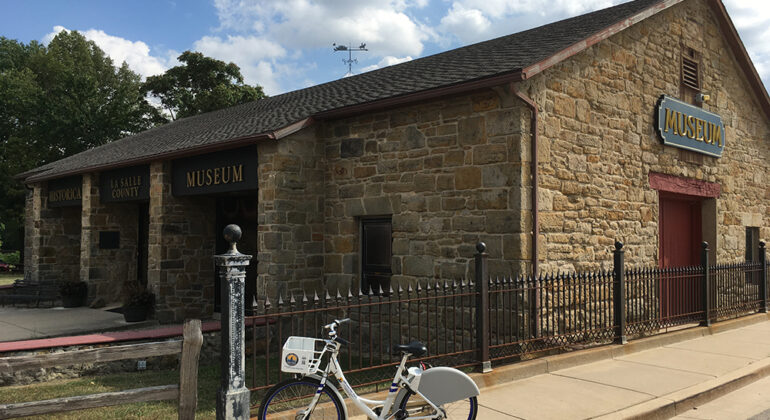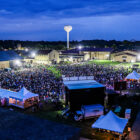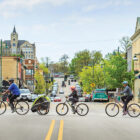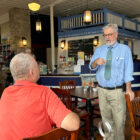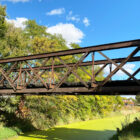by Nancy Uznanski
Centered in Utica, Illinois, the historical society was founded in 1907. Members kept it going as they collected and protected artifacts and LaSalle County history. Then with the right catalyst, a building to display their wonderful and sometimes curious treasures appeared.
That catalyst was Edmund B. Thornton, said Mary Holland, Historical Society Vice-President. In the 1960’s he led the search and made the deal.
“That was a huge step!” she said.
Built from sandstone cut into blocks, a warehouse that opened in 1848; the same year the historic Illinois and Michigan (I&M) Canal opened, in the late 1960’s became the Canal Warehouse Museum.
It started a trend and more buildings were acquired. By 2012 they had a museum campus including three more historic structures: a one room school house built in 1865, a Barn from 1875 that houses a farming exhibit, and a blacksmith shop built in 1892.
They also have two off campus additions, including an artesian well in Ottawa, and a train on permanent loan to the Mendota museum, according to Museum Director Amanda Carter.
Then, thanks to the perseverance of Douglas Holland, Mary’s husband, the campus grew from the original four to six, Carter said.
One, previously known as the Utica Lumber Shed, opened in 2014 as the Canal Market. The other, once used for grain storage, opened in 2016 as the Heritage Center.
“The purchase has allowed them to expand and modernize,” said Ana B. Koval President CEO Canal Corridor Association.
The Heritage Center became the perfect counterpart to our first museum,” Carter noted.
Open from noon to four p.m., Friday through Sunday, she said the Canal Warehouse Museum houses pre-1900 items and the new Heritage Museum houses artifacts from 1900 through the present.
Some items in the Canal Warehouse Museum include the carriage Abraham Lincoln rode in to the Lincoln-Douglas debate in 1858, and exhibits on the I&M Canal, abolitionists, the Civil War, and the Zimmerman collection of tools, weapons and other artifacts from the native Grand Village of Kaskaskia, she said.
In the other, the lower level includes a coal mineshaft exhibit; a reminder of the many coal companies that mined along the I&M Canal corridor from the 1860’s to mid 1900’s. The third level includes a new climate controlled collections area plus space for meetings and events.
The main floor includes exhibits from World War I to Afghanistan, artifacts from Lindberg’s plane crash, and information about residents from LaSalle County who became prominent across the country.
“Our Radium Girls exhibit is one of our best known,” Carter said. “Kate Moore, the author of The Radium Girls, came in and did part of the research for her book here. We have the letters written by Pearl Payne that helped win the lawsuit against the company that hired them.”
Payne was one of the young women who died from cancer after painting glowing dials on clocks, watches and instrument panels for the Radium Dial Company in Ottawa during the 1920’s.
“Since we are digitizing our collections now, when Kate needed more information we were able to share that collection with her through the internet,” Holland said.
Carter noted that many other people are still well known, like the folk hero, Wild Bill Hickok. Others are remembered for what they did, like Clyde Tombaugh, the scientist who discovered Pluto, and Bob McGrath, who played the Sesame Street character, music teacher and friendly neighbor Bob Johnson.
Carter also said they have had good fortune due to several grants and donations, yet, with their projects and expenses, regular fundraisers help generate needed capital. In May, Wild Bill Days is relatively new and becoming quite popular, she said. The ‘Canal Market’ runs on weekends through the warmer months. And on Columbus Day Weekend they have Burgoo Festival.
“Our biggest event, the Burgoo Festival was started in 1969,” Carter said. “Burgoo is a stew that settlers would make as a kind of celebration after they harvested their crops in the fall. A little different each year, it was made of vegetables and meats from domestic animals and wild game.”
In 2013, it became a two day festival. With entertainment and lots of vendors, Saturday centers on the village. On Sunday she said they focus on the Burgoo and always add a historic twist.
“My favorite part of the festival is Saturday night after everybody leaves and we start the stew,” Carter said. “All night we have six big kettles sitting over open fires that we build right next to the I&M Canal. The kettles are filled with vegetables and meats volunteers have cut up during the day, and when the stirrers start adding garlic and spices, it’s gets smoky and smells sooooo good!”
Noting one of the projects fundraisers help, Vice President Holland concluded, “Now that we are digitizing everything, we can reach out to smaller county museums to help them grow if they like. There’s always room for more.”
Nancy Uznanski is a freelance writer.
